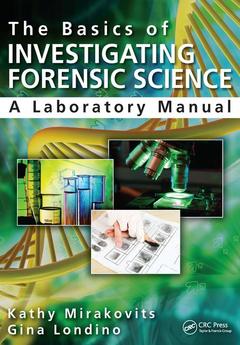Description
The Basics of Investigating Forensic Science
A Laboratory Manual
Authors: Mirakovits Kathy, Londino Gina
Language: English
Subjects for The Basics of Investigating Forensic Science:
Approximative price 222.92 €
In Print (Delivery period: 13 days).
Add to cart· 17.8x25.4 cm · Hardback
Description
/li>Contents
/li>Biography
/li>
FORENSIC SCIENCE AND CRIME SCENE INVESTIGATION
Introduction to Crime Scene Investigation: Solving the Puzzle
Introduction
Pre-Laboratory Questions
Scenario
Procedure
Locard’s Exchange Principle: Transfer of Evidence
Background
Pre-Laboratory Questions
Scenario
Materials
Procedure
Post-Laboratory Questions
Physical Matches
Introduction
Pre-Laboratory Questions
Scenario
Procedure
Summary Questions
Worksheet
The 3Ls: Locating, Lifting, and Logging Evidence
Introduction
Pre-Laboratory Questions
Scenario
Materials
Procedure
Post-Laboratory Discussion Questions
Evidence Collection: Making an Evidence (Drug) Fold
Introduction
Pre-Laboratory Questions
Materials
Procedure
Classifying Evidence: Is This Class or Individual Evidence?
Introduction
Materials
Procedure
Follow-Up Questions
The Basic Crime Scene Sketch
Introduction
Pre-Laboratory Questions
Scenario
Materials
Procedure
Follow-Up Questions
Crime Scene Investigation
Introduction
Pre-Laboratory Questions
Scenario
Procedure
Summary Questions
PATTERNS AND IMPRESSIONS
Fingerprints
Introduction
Pre-Laboratory Questions
Scenario
Procedure
Summary Questions
Worksheet
Questioned Documents
Introduction
Pre-Laboratory Questions
Scenario
Procedure
Advanced Laboratory Procedure
Summary Questions
Worksheet
Firearms Identification Web Quest
Procedure
Questions to Answer
Case File Exercise
Basic Firearms Identification: Examining Bullets and Cartridge Casings
Introduction
Pre-Laboratory Questions
Scenario
Materials
Procedure
Post-Laboratory Questions
Basic Toolmark Identification: Screwdriver Comparison
Introduction
Pre-Laboratory Questions
Scenario
Materials
Procedure
Post-Laboratory Questions
Shoeprints
Introduction
Pre-Laboratory Questions
Scenario
Procedure
Summary Questions
Worksheet
FORENSIC BIOLOGY
Serology
Introduction
Scenario
Pre-Laboratory Questions
Procedure
Advanced Laboratory Procedure
Discussion Questions
Advanced Questions
Worksheet
Pathology: The Autopsy
Introduction
Pre-Laboratory Questions
Materials
Procedure
Post-Laboratory Questions
DNA Analysis
Introduction
Scenario
Pre-Laboratory Questions
Procedure
Advanced Laboratory Procedure
Discussion Questions
Advanced Questions
Worksheet
Hairs
Introduction
Scenario
Pre-Laboratory Questions
Procedure
Discussion Questions
Worksheet
Forensic Anthropology: Determination of Stature
Introduction
Pre-Laboratory Questions
Scenario
Materials
Procedure
Post-Laboratory Questions
Basic Bloodstain Pattern Analysis
Background
Pre-Laboratory Questions
Scenario
FORENSIC CHEMISTRY
Inks
Introduction
Pre-Laboratory Questions
Scenario
Procedure
Summary Questions
Worksheet
Illicit Drugs
Introduction
Pre-Laboratory Questions
Scenario
Procedure
Advanced Laboratory Procedure
Summary Questions
Advanced Summary Questions
Worksheet
White Powder Testing
Introduction
Scenario
Materials
Procedure
Post-Laboratory Questions
Calculating Blood Alcohol Concentration: The Widmark Formula
Introduction
Fibers
Introduction
Pre-Laboratory Questions
Scenario
Procedure
Summary Questions
Worksheet
Polymers
Introduction
Pre-Laboratory Questions
Scenario
Procedure
Summary Questions
Fire Debris
Introduction
Pre-Laboratory Questions
Scenario
Procedure
Summary Questions
Worksheet
Explosives
Introduction
Pre-Laboratory Questions
Scenario
Procedure
Summary Questions
Worksheet
FORENSIC PHYSICS
Accident Investigation: Skid to Stop Mathematics
Introduction
Pre-Laboratory Questions
Procedure
Work Space for Calculations
Post-Laboratory Questions
Glass
Introduction
Pre-Laboratory Questions
Scenario
Procedure
Summary Questions
Worksheet
Forensic Analysis of Glass: Identifying the Type of Glass
Introduction
Pre-Laboratory Questions
Scenario
Post-Laboratory Analysis
Measuring the Diameter of a Human Hair
Introduction
Pre-Laboratory Questions
Materials
Procedure
Apparatus Setup
Post-Laboratory Questions
Kathy Mirakovits teaches forensic science and physics at Portage Northern High School in Portage, Michigan, and physics at Kalamazoo Valley Community College in Kalamazoo, Michigan. She holds a master’s degree in science education from Western Michigan University and has completed over 15 graduate hours in forensic science. She has taught at the high school and two-year-college levels for a total of 25 years, teaching general science, physical science, chemistry, biology, earth science, and physics. She conducts workshops across the United States for teachers who wish to learn the application of forensic science in a school curriculum. She currently serves as the high school director for the Michigan Science Teachers Association.
Gina Londino received her master’s degree in chemistry from Purdue University in Indianapolis. Her main focus in graduate school was in forensic analysis of pigmented ink using pyrolysis gas chromatography-mass spectrometry. She also performed research on biomarkers at Eli Lilly and Company, Indianapolis, through the ADME department throughout graduate school. Gina is currently a senior lecturer in the Forensic and Investigative Sciences program at Indiana University–Purdue University, Indianapolis, where she has been teaching introductory courses in forensic science, forensic chemistry, and forensic microscopy since 2006. She has designed multiple courses in forensic science, including a variety of beginner-to-advanced laboratory exercises.




